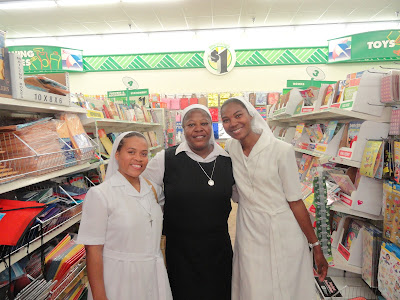Religious
life has come a long way. Before Vatican 11 almost every vowed religious sisters
in the United States wore habit, the old fashioned uncomfortable common dress
of poor women of middle ages. Following Vatican II, and the promulgation of Ecclesiae Sactae by Pope Paul VI in
1966, sisters were permitted to experiment with habit modification according to
the needs of the time and place for a period of time, without compromising the
purpose, nature and character of their institutes. As times continue to change
and new opportunities for ministry continued to open up for sisters, interest
in wearing traditional habits waned to the extent that the habit gradually came
to be seen as a symbol of oppression and obsolescence. Eventually around the
1980’s, most congregations in the United States discarded the habit altogether.
I
know all about this as a former Dominican Sister. I was raised n Nigeria where sisters still dress in habit and as a Dominican sister myself, I wore one anytime I was in public. But when
I came to the United States, I noticed that sisters wear ordinary every day
clothes. Upon inquiry, I learned that most congregations see their
congregational crosses and solemn vows ring as their only visible distinctive
form of identification. It was a phenomenal experience for me.
As
an apostolic novice, I am discerning the call to commit my life to God in the
Congregation of the Sisters of Divine Providence, Melbourne, Ky. Long ago I
grappled with the question of sisters’ invisibility in the United States. So, when
the issue was raised at a gathering of young sister which I attended last year, I
was eager to hear the opinion of other younger/newer members. The discussion bothers
on visibility versus non visibility of religious sisters in the Unites States. While
majority of those in the group said they are happy and comfortable looking simple
and ordinary, a few indicated that they sometimes struggle with being
incognito. In other words, they seem to be suggesting that there are times when
they wished they could be more visible, without necessarily wearing a habit. At
the end of the discussion, we did not really come up with any concrete solutions.
Personally,
I do not struggle with being incognito. Perhaps my experience of being a religious
sister in Nigerian (a habited culture) and now in formation in the United
States (where habit is not the norm) made me recognize the need for a middle
space. Some sisters are called to wear habit and others are not. While these two
forms of dressing represent the same authentic reality, I am all for a blend of
both forms of dressing. As we well know, dressing distinguishes people. soldiers, sailors, doctors, flight attendants, priests, monks, bishop, altar
servers and so on, are all recognized by what they wear. But this does not mean
that they have to look that way all the time. Doctors don’t go fishing or
golfing with stethoscopes hanging on their necks, neither would priests be
comfortable swimming with Roman collars. In the same way, I have no problem with wearing distinctive garbs when occasion calls for it.
So does this mean that I am advocating for a return to the traditional full habit like it was in the Middle
Ages? By no means. However I think a mild modification is ok for
our day and time. Thankfully, our CDP constitution makes room for such accommodation. The Constitution of the CDP Congregation states that
our CDP cross and ring remain the distinctive sign of our consecration and
membership, and that whatever we wear is a sign of consecration and a witness of
our simplicity and poverty. At the same time, our constitution also
makes provision for sisters who may choose to wear a veil, (and there are a few who
do so). Those few sisters dress in simple skirt and blouse with a simple veil. For me, a simple skirt and blouse is also a contemporary attire. Skirt and blouse will certainly not inhibit a sisters ability to walk, drive a car or effectively carry out ministry, which were some of the
reasons raised for discarding the veil or habit, among other things.
I hope that no one opts for religious life just to be
recognized. Jesus even warned his disciples against making a pompous show of
their good deeds. But at the beginning of his public ministry, Jesus made
himself publicly known. In the Gospel, Jesus read from the scroll and afterwards declared that he is
fulfilling what he just read. (Luke 4:21) It would have been impossible for
Jesus to effectively proclaim his message of salvation without some form of
publicity. As a matter of fact, the entire Gospel is the eye witness account of the Jesus’ three
years of public ministry. In the same vein, I strongly believe that the same
Jesus who remains the same yesterday, today and forever wants to continue to be
proclaimed and publicized until his return.
So what is the connection between the call of sisters to make
Jesus known and the importance of being recognized as sisters? To begin with
there are so few of us today in the United States. Recently I introduced myself
to somebody and she said she didn’t know that people still joined religious life
today because they are hardly seen. This is the more reason why we should be identifiable.
In this day and time when people are going to court to have the crucifix and
Christian images removed from public offices, we need to show ourselves as an
irreplaceable sign of God’s Presence. We need to be seen by younger adults who
are the future of religious life/church as they continue to choose between opposing
alternatives in our increasingly secularized society. Yes, we need to let them now that we are still here, they need to not only hear us, but see us as well.
The 1983 document on Essential Elements in the Church’s Teaching on Religious Life published by the Sacred Congregation for Religious and Secular
Institutes stated that the witness of religious life is public. This was
affirmed in Canon 669 which echoed the importance of habit for
religious women. Furthermore, Vatican II’s Perfectae Caritatis clarified
that religious habits could be modified for reasons of health, practicality and
effectiveness in ministry (#17).
If you ask me, our call/mission today is public and distinct, just like that of Jesus. No one acts in secret says the gospel of John if he/she
wants to be known publicly (John 7:14). For me the veil is not about
the individual who wears it, nor is it about their comfort, or popularity. Being visible is
mainly about Christ, about religious life, about the Holy Catholic Church, and especially
about those seeking a deeper relationship with God. My experience with wearing a white veil has been mostly positive. On
occasions, I have been approached, stopped and questioned. I have had the privilege
to answer questions, clear doubts, and discuss my Catholic faith with both
Christians and non-Christians. Being visible as a sister has given me the
opportunity to share how we live the four fundamental virtues of simplicity,
poverty, charity and abandonment to Providence. I have prayed and accepted
prayer requests from complete strangers because they feel safe sharing their
concerns with someone who will not judge or criticize them. People have walked up to me to discuss their pains, and thanked me for just being and for listening without any judgment. So if the veil
offers me the opportunity to share the radical love of Christ with those who
approach me because I am more visible, then I am more than happy to wear it
irrespective of the seeming inconvenience it constitutes.
On the other hand, I have also noticed curious stares directed
my way because of the veil. I understand that there are people out there who
may be put off by the veil or who may feel too uncomfortable to ask me for
prayers, and that is okay. The way I see it, the advantage of touching even a
single life each day I go out wearing a simple veil, and being visible, far outweighs all contrary opinions.
As
an individual, I am comfortable with wearing the veil sometimes, because it offers me the opportunity to witness Christ in a unique way. As
a sign of consecration to God, the veil serves as a constant reminder that
consecrated women belongs to God. The veil is not fashionable, but counter cultural,
which is exactly what sisterhood is about. In witnessing to the faith they profess,
wearing the veil enhances a sister’s practice of the religious vow of poverty. Those
who wear habit spend less time and money thinking about or shopping for what to wear. In
this regards, the veil is liberating.
On
the other hand, majority of sisters in the United States are old and retired. I
think it is unrealistic to expect them to dress otherwise. Consequently, the issue
of visibility may only be relevant to younger/newer members as was raised at the Giving Voice Gathering I had refereed to earlier. But in the spirit of communal
charity, it will be great for older sisters to recognize and support
younger/newer members who wish to wear habit/veil and not continue to insist
on polarity of dressing. The mark of our our unity is portrayed our ability to be of one mind and heart not by how the spirit is leading us to dress. In addition, religious Congregations in the United State should recognize that some newer members are from cultures where wearing the veil is still a norm. How would such sisters deal with these duality, when for example they visit home?
Religious life has survived the era when most sisters dressed in habit and now when majority do not in the United States. Could the future be
calling for a blend of the two forms? I would think so, because both forms have
their own merits. We need sisters who are recognizable and those who are not to
assimilate the needs of everybody. So as we continue to wrestle with the issue
of sister’s visibility/invisibility, what is important is
to remember that whatever we wear, should be worn with the right intention. Let us
continue to persevere in following the good intentions of our hearts and not
criticize those who dress differently from us, because our journey into the
divine mystery is deeper than a garb. May the radical love of Jesus continue to
illumine out hearts as we continue to risk personal transformation for the sake
of God and the coming of his kingdom. Amen!
Rosemarie (right) and Emiline, CDP sisters from Madagascar
























